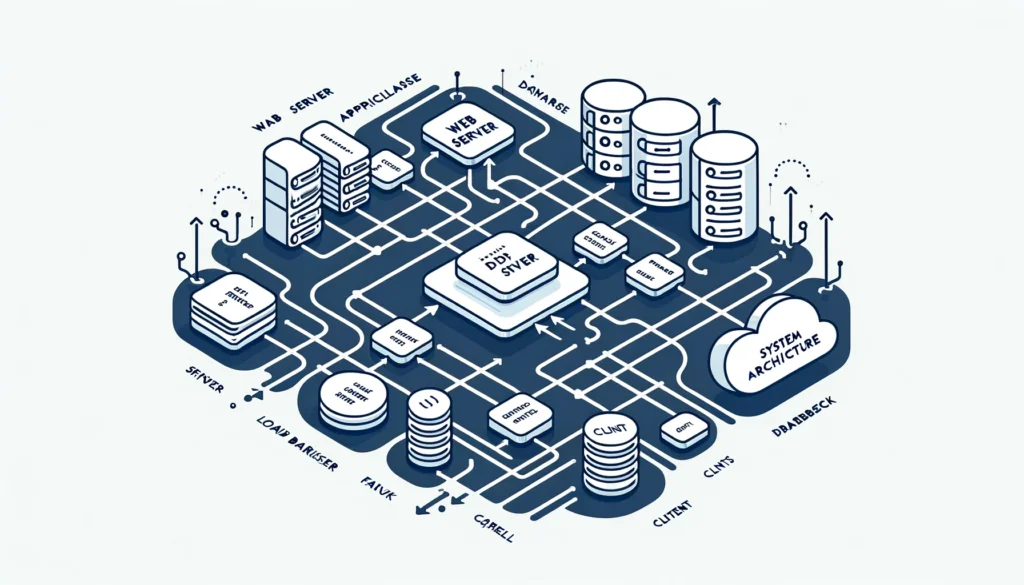System design plays a crucial role in software development as it sets the stage for the entire development process.
Welcome to system design for aspiring software engineers. In this article, we will provide you with a foundation in system design to excel in the field of software engineering.
Understanding System Design
Before diving into the principles and process of system design, it’s important to have a clear understanding of what system design actually entails. System design refers to the process of defining the architecture, components, and interactions of a software system. It involves making strategic decisions to ensure the system meets the desired requirements and objectives.
System design plays a crucial role in software development as it sets the stage for the entire development process. It helps in identifying potential bottlenecks, anticipating scalability challenges, and ensuring the system is reliable, efficient, and secure.
It’s worth noting that system design is often confused with software architecture.
While both are related, they serve different purposes. Software architecture focuses on the high-level structure and organization of the system, whereas system design delves into the finer details of implementation and functionality.

Key Concepts in System Design
| Term | Description | Learn More |
|---|---|---|
| Throughput | Measures the amount of data successfully transmitted in a system over a specific time period, typically in bits per second (bps). | System Design Primer – Throughput |
| Latency | Time taken for a single piece of data to be delivered successfully, measured in milliseconds (ms). High latency can lead to delays in system responses. | System Design Primer – Latency |
| Availability | Refers to the system’s ability to remain operational and respond to client requests consistently. It quantifies how often the system is accessible within a given time window. | System Design Primer – Availability |
| Redundancy | Involves duplicating critical components or functions within a system to ensure continued operation in case of failures. | System Design Primer – Redundancy |
| Consistency | Ensures that data remains uniform across all nodes in a distributed system, preventing inconsistencies that can arise due to replication delays. | System Design Primer – Consistency |
| Scalability | Involves designing systems that can handle increasing amounts of data, traffic, and users without compromising performance. | System Design Primer – Scalability |
| Reliability | Ensures that the system operates as intended and is fault-tolerant, minimizing the impact of failures. | System Design Primer – Reliability |
| Efficiency | Optimizing performance and resource usage through careful design of algorithms, data structures, and caching mechanisms. | System Design Primer – Efficiency |
System Design Process
Now that we have covered the essential principles of system design, let’s take a look at the system design process:
Requirements Gathering and Analysis
The first step in the system design process is to gather and analyze the requirements of the system. This involves understanding the needs of the users, identifying functional and non-functional requirements, and defining the scope of the system.
Defining System Architecture and Choosing the Right Patterns
Once the requirements are clear, the next step is to define the system architecture. This involves identifying the major components of the system, their interactions, and choosing the appropriate architectural patterns and design principles to guide the implementation.
Modeling and Design Strategies
Modeling is an important aspect of system design as it helps in visualizing the system and its components. This can be done using various modeling techniques such as UML (Unified Modeling Language) diagrams, flowcharts, and entity-relationship diagrams. Additionally, design strategies such as separation of concerns and modular design should be employed to ensure a maintainable and extensible system.
Prototyping and Validation
Prototyping plays a crucial role in system design as it allows you to test and validate your design before the actual implementation. By creating prototypes, you can gather feedback, identify potential issues, and make necessary improvements to your design.
Tools and Technologies
In the world of system design, there are various tools and technologies available to aid in the design process. Some popular tools include:
| Name | Description | Pros | Cons |
|---|---|---|---|
| Sketch | Sketch is a premium design tool widely accepted for its smooth handling of big files and providing CSS styling info for developers. | Great prototyping features, Repeat Grid feature, Ease of sharing, Smooth run ability, Value | Some features missing compared to competitors like Figma and Sketch |
| Adobe XD | Adobe XD is a specialist web tool known for its ease of use and components library for import across files. | Specialist web tool, Ease of use, Components library for import across files | Text handling limitations, Lack of expected functionality in some areas |
| Balsamiq Cloud | Balsamiq Cloud is a tool for designing and reviewing user interfaces online. It offers project sharing controls, real-time co-editing, threaded comments with callouts, integration with Slack, and project history features. | Great prototyping features, Repeat Grid feature, Ease of sharing, Smooth run ability, Value | New features being fine-tuned, Dependency on Plugins, Missing Rollover ability in Prototyping |
Modeling and Prototyping Tools
Tools such as Sketch, Adobe XD, and Balsamiq can be used for creating mockups and prototypes of your system. These tools allow you to visualize the user interface and interactions, making it easier to communicate your design ideas.
Architecture and Design Tools
Tools like Lucidchart, Draw.io, and Visual Paradigm provide a platform for creating system architecture diagrams and visualizing the components and interactions of your system.
It’s important to choose the right tool based on your specific requirements and familiarity with the tool. Remember, the tool is just a means to an end, and the focus should always be on the design principles and concepts.
Best Practices in System Design
While the principles and process of system design are important, following best practices can further enhance the quality and effectiveness of your designs:
Emphasizing Modular Design
Modular design promotes separation of concerns and reusability of components. By breaking down your system into smaller, independent modules, you can improve maintainability, testability, and flexibility.
Importance of Documentation and Clear Communication
Documentation plays a vital role in system design as it helps in understanding the design decisions, system architecture, and interactions. Clear and concise documentation ensures that the design is well-communicated and can be easily understood by other team members.
Continuous Evaluation and Iteration
System design is an iterative process, and it’s important to continuously evaluate and improve your designs. Solicit feedback from peers, conduct design reviews, and learn from existing systems to refine your design skills.
Learning from Case Studies and Existing Systems
Studying case studies and analyzing existing systems can provide valuable insights into real-world design challenges and solutions. By understanding how successful systems are designed, you can learn from their best practices and apply them to your own designs.
Would you like to get engaged with professional Specialists?
We are a software development team with extensive development experience in the Hybrid and Crossplatform Applications development space. Let’s discuss your needs and requirements to find your best fit.
Usecase: System Design At Netflix
A real-world use case that exemplifies the success of good system design can be seen in the transformation of Netflix’s streaming service. Initially, Netflix operated as a DVD rental service, mailing DVDs to customers. However, with the rise of digital streaming, Netflix had to pivot its business model and develop a robust system design to support its transition to online streaming.
By investing in a well-thought-out system design, Netflix was able to create a scalable, reliable, and user-friendly streaming platform.

SYSTEM DESIGN AT NETFLIX
The company focused on optimizing its content delivery network (CDN), implementing efficient data storage solutions, and enhancing its recommendation algorithms to personalize user experiences.
Netflix’s system design allowed for seamless streaming experiences, personalized recommendations, and adaptive video quality based on users’ internet speeds. This resulted in high customer satisfaction, increased user engagement, and ultimately led to Netflix becoming a dominant player in the streaming industry. The success of Netflix’s transition from a DVD rental service to a global streaming giant showcases how a good system design can drive innovation, improve user experiences, and propel business growth in the digital era.
Preparing for System Design Interviews
System design interviews are a common part of the software engineering interview process. To effectively prepare for these interviews, consider the following:
Overview of the System Design Interview Process
Understand the typical structure and expectations of a system design interview. Familiarize yourself with the types of questions asked and the evaluation criteria used by interviewers.
Key Topics to Master for Interviews
Focus on mastering key topics such as scalability, reliability, availability, efficiency, and security. Understand the trade-offs involved in making design decisions and be able to justify your choices.
Tips for Effectively Communicating Your Design
Communication is key in system design interviews. Practice explaining your design choices clearly and concisely. Use visual aids, diagrams, and examples to support your explanations.
Practice Questions and Resources for Further Study
There are various online resources and practice questions available to help you prepare for system design interviews. Utilize these resources to gain confidence and improve your design skills.
Dedicated Full Stack Developers
Hiring Full Stack developers gives businesses access to pros proficient in various technologies and frameworks. Their versatility streamlines collaboration, leading to faster development and enhanced efficiency.
So system design is a fundamental aspect of software engineering, and mastering it is essential for emerging software engineers. By understanding the principles, following best practices, and continuously learning and improving, you can lay a solid foundation for a successful career in software engineering. We hope this comprehensive guide has provided you with the necessary knowledge and resources to embark on your system design journey. Remember, practice and application are key to deepening your understanding and becoming a proficient system designer. Good luck!





